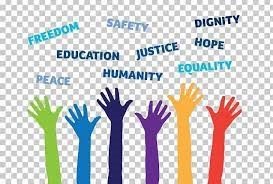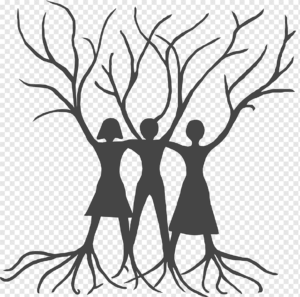Marginalisation and Empowerment
“Social empowerment is not a luxury, it is a necessity for a thriving and inclusive society.”
Social empowerment refers to the process of enabling indMarginalisation and Empowermentividuals and communities, especially the marginalised, to participate fully in social, economic, and political life. Marginalisation occurs when certain groups—such as Dalits, Adivasis, women, minorities, and persons with disabilities—are systematically excluded from access to resources, rights, and opportunities.
These marginalised groups become the targets of empowerment through affirmative action, legal safeguards, inclusive policies, and capacity-building initiatives. Social empowerment ensures equality, dignity, and justice by promoting education, representation, and economic participation. It is essential for building an inclusive society where all individuals can realize their full potential and contribute meaningfully.
Marginalisation
- Marginalisation
- Dimensions of Marginalisation
- Marginalised groups in India
- Empowerment
- Dimensions of Empowerment
- Importance of Social Empowerment
- Need for Social Empowerment
- Is Social Empowerment necessary or they are already empowered?
- Social Empowerment and Governance
- Foundational Concepts
- Disempowered Sections
- Government Initiatives for Social Empowerment
- Challenges in Social Empowerment
- Addressing the Challenges of Social Empowerment
- Related FAQs of Marginalisation and Empowerment
Marginalisation in conventional parlance is a complex process of relegating specific group(s) of people to the lower or the outer edge of society. It effectively pushes these groups of people to the margin of society following the parameters of exclusion and inclusion economically, politically, culturally, and socially.
Dimensions of Marginalisation
- Denials and deprivations
- Economically denies a large section of society equal access to productive resources, avenues for the realisation of their productive human potential, and opportunities for their full capacity utilisation.
- Politically, this process of relegation denies these people equal access to the formal power structure and participation in the decision-making processes leading to their subordination to and dependency on the economically and politically dominant groups of the society.
- Culturally excluded from the mainstream of society becoming the ‘part society with part culture’, ‘outsider for within’, alienated and disintegrated.
- Socially ignorant, illiterate, uneducated and dependent. Devoid of the basic necessities of life, they are relegated to live in the margin of society with a subhuman existence.
- Artificial structure of hierarchy
- The natural differentiation between men and women, linguistic or ethnic groups and so on are put in an order of hierarchy with the guiding principle of domination and subordination.
- This process of hierarchisation has arranged social groups in the steep ordering of people, with a powerful few at the social and economic command deciding the mainstream of the society, polity and the economy.
- A powerless majority, occupying the bottom of the socio-economic hierarchy and surviving at the periphery of the social order.
- Bases of legitimacy and reproduction
- The process of marginalisation has also been historically embedded in a socio-cultural context.
- Significantly there are strong institutional, normative and ideological bases, stemming out of the primordial interpretation of the institutional and normative arrangements of caste, ethnicity, race, gender, patriarchy, religion and so on, to provide legitimacy to the processes of marginalisation.
- Again, the ongoing processes of socialisation, education, politicisation, enculturation etc contribute to their reproduction in society.
- Thus over time, the socially constructed marginalised categories tend to appear to be the empirical categories of the low caste, tribes, women, blacks and so on.
- The Human Development Report (1996), has drawn attention to the realities of ‘jobless’, ‘voiceless’, ‘ruthless’, ‘fruitless’ and ‘futureless’ growth, all of which contribute, directly to creating a marginalised population.
Marginalised groups in India
The social categories such as the Scheduled Castes (SCs), Scheduled Tribes (STs), Other Backward Classes (OBCs), educationally backward minorities, women, children, aged, spatial categories like backward/remote villages and slum dwellers.
Economic categories include people living below the poverty line, petty artisans, landless agricultural labour, semi-landless marginal cultivators, unskilled or semiskilled construction labourers, workers of the unorganised sectors etc.,
Special categories like the physically challenged etc.,
Empowerment
Empowerment refers to the process of giving people the tools, resources and opportunities to gain control over their lives and make decisions that affect their well-being. ‘
It involves fostering confidence, access to information and the ability to influence social, economic or political environments. Empowerment can occur at individual, group or community levels and is a key factor in driving positive social change.
Empowerment takes various forms, each focusing on different aspects of an individual’s or community’s ability to gain control over their life.
Dimensions of Empowerment
What tools do you think a person requires in order to gain control over their lives?
You would probably answer – Enough money, rights and social standing. This is exactly what we need to empower the citizens. This is what a person needs to have in order to gain enough confidence to achieve whatever one can achieve in a lifetime after working hard enough.
The primary types of empowerment include:
- Economic Empowerment: This involves providing individuals with financial independence and access to resources and employment opportunities.
- Political Empowerment: It ensures that all groups have a voice in governance. By securing representation in political institutions people can advocate for policies that reflect their needs.
|
- Social Empowerment: It focuses on enabling individuals and communities to challenge social norms, fight inequality and access necessary services. It promotes a more inclusive and just society by ensuring equal rights and opportunities, regardless of gender, caste or social class.
- Gender Empowerment: It addresses the inequalities between men and women and promotes equal access to resources, opportunities and rights. This enables them to participate fully in social, economic and political life, thus contributing to the development of the entire society.
Importance of Social Empowerment
Out of the above-mentioned dimensions of empowerment, Social empowerment is the most critical form of empowerment because it directly impacts the ability of individuals and communities to access resources, exercise rights, and participate fully in societal development.
It is more fundamental compared to other forms of empowerment in the following ways:
- Foundation for Other Empowerments: Social empowerment lays the groundwork for economic, political and cultural empowerment by ensuring access to education, healthcare and rights.

- Reduces Structural Barriers: It addresses systemic issues like caste, gender and class discrimination, helping marginalized groups overcome poverty and exclusion.
- Promotes Equity: Ensures fair access to public services, reducing inequalities and improving overall quality of life.
- Strengthens Human Capital: Enhances workforce capabilities through better healthcare, education and social protection, driving sustainable economic growth.
- Enables Political Participation: Increases awareness of rights, fostering greater political engagement and improved governance.
Need for Social Empowerment
The need for social empowerment arises to address inequalities, foster inclusivity and ensure holistic societal progress. The reasons are given below why social empowerment is crucial for building a fair, just and progressive society where every individual has the opportunity to thrive.
- Addressing Social Inequalities: Persistent disparities based on caste, gender, class, and ethnicity necessitate social empowerment to create a more equitable society.
- Breaking the Cycle of Poverty: Empowerment provides marginalized groups with access to education, healthcare and economic opportunities, helping them escape poverty.
- Ensuring Human Rights and Social Justice: It is essential to uphold basic rights and ensure fair treatment, dignity and freedom for all individuals.
- Promoting Inclusive Development: Empowered societies enable wider participation in economic, political, and cultural spheres, fostering balanced and sustainable development.
- Strengthening Democratic Participation: Empowered citizens are more likely to engage in governance, demand accountability, and contribute to better decision-making processes.
- Including the socially excluded population: To ensure equitable access to resources, opportunities and participation of all in societal progress and development.
Is Social Empowerment necessary or they are already empowered?
Social empowerment is a crucial process for fostering equality, inclusion and justice. While some individuals and groups may already have a degree of empowerment, many marginalized or vulnerable communities still face systemic barriers that limit their access to opportunities and resources. These groups often lack the tools, confidence or support necessary to influence their social, economic, and political environments effectively.
Even in societies where some degree of empowerment exists, disparities still persist, particularly among women, minorities, lower-income groups, rural populations and other marginalized communities.
In some cases, empowerment might need to be complemented with education, healthcare access, economic opportunities and social justice initiatives. However, social empowerment itself plays a foundational role in ensuring that individuals and communities can make decisions that affect their lives and push for policies that reflect their needs and aspirations.
Social Empowerment and Governance
Social empowerment is crucial for ensuring effective governance, as it enables marginalized communities to participate actively in decision-making processes, leading to policies that address their needs and reflect their interests. Here are six key points on how social empowerment contributes to better governance:
- Inclusive Decision-Making: Social empowerment ensures marginalized communities are included in governance, leading to policies that are more representative of the diverse needs of society.
- Enhancing Accountability: Empowered citizens can hold governments accountable by demanding transparency, fighting corruption, and ensuring that policies serve the public good.
- Strengthening Democracy: Empowered populations are more likely to engage in voting, advocacy, and public discourse, which strengthens democracy and ensures leaders remain responsive to people’s needs.
- Promoting Gender Equality: Social empowerment promotes gender equality by encouraging women’s participation in governance, resulting in policies addressing gender-specific issues like healthcare, education, and economic equality.
- Community-Led Governance: Empowered communities can drive local governance and development, ensuring that solutions are tailored to their specific needs and concerns.
- Conflict Resolution and Social Cohesion: Empowered communities are better equipped to resolve conflicts peacefully, contributing to social harmony, stability, and cooperation.
| Social Empowerment and Sustainable Development Goals (SDGs) |
|
Social empowerment is closely linked to several SDGs, particularly those focused on reducing inequalities, ensuring access to quality education and promoting social justice.
|
Foundational Concepts
Social empowerment is a multidimensional concept, which emphasizes equity, participation, capacity building, social inclusion and human rights, fostering inclusive development and social justice.
Addressing systemic barriers and promoting collective action, contributes to stronger and more resilient societies where every individual has the opportunity to thrive.
- Social Justice
- Social justice emphasizes the importance of dismantling barriers to full participation in societal, economic and political life. By promoting fair distribution of resources, protecting human rights and ensuring representation for all, social justice serves as a core pillar of empowerment, fostering a more equitable and inclusive society.
- Equity
- Equity focuses on ensuring fair and just access to resources, opportunities and rights for all individuals, particularly marginalized and disadvantaged groups.
- Unlike equality, which treats everyone the same, equity recognizes differences in social positions and seeks to provide targeted support to overcome structural barriers.
- It aims to create a level playing field by addressing systemic inequalities related to gender, caste, race, economic status and other factors, thereby fostering a more inclusive and balanced society.
- Human rights and Dignity
- Human rights are essential freedoms, such as the right to life, speech, education and fair treatment, which empower individuals to make informed choices and participate fully in society.
- These rights form the foundation for personal growth and societal engagement. Dignity, closely linked to human rights, emphasizes the inherent worth of every individual, ensuring they are treated with fairness and respect, free from exploitation and discrimination.
- When both human rights and dignity are upheld, individuals, especially marginalized groups, feel valued and empowered to contribute meaningfully, fostering a just and inclusive society for all.
Disempowered Sections
Disempowered sections refer to groups within society who lack the resources, opportunities and power to influence decisions that affect their lives. These sections often face systemic barriers related to their socioeconomic status, gender, age, disability or ethnicity.
As a result, they are marginalized and denied access to essential services, economic opportunities and participation in social, political and cultural life. These groups may face challenges in achieving social, political, and economic empowerment, thereby hindering their ability to improve their well-being.
Here are some of the most common Disempowered sections in society:
- Women and Girls:
- Women, particularly in patriarchal societies, often face social and economic disparities. Despite progress in many areas, women still face unequal access to education, healthcare, employment and leadership roles.
- Gender-based violence, discrimination and limited access to resources often hinder women’s ability to exercise their rights fully.

- Minority and Marginalized Communities:
- Ethnic, religious and linguistic minorities often face exclusion, discrimination and limited access to resources and opportunities.
- These communities are often economically disadvantaged and may face social isolation. Caste-based discrimination is another significant barrier in countries like India, where the Dalits and Adivasis face exclusion and violence.
- Persons with Disabilities:
- People with disabilities often encounter barriers related to accessibility, education, employment and social acceptance.
- Lack of awareness, inadequate infrastructure and discrimination can hinder their full participation in society, leaving them vulnerable to marginalization.
- Elderly People:
- Older adults, especially those who are economically disadvantaged, may experience social exclusion, lack of adequate healthcare and limited opportunities for engagement in social and political life.
- Their needs are often overlooked in decision-making processes, leading to neglect and vulnerability.
- Children and Youth:
- Children and youth, particularly from disadvantaged backgrounds, may have limited access to quality education, healthcare and opportunities for personal growth.
- In many cases, children from impoverished families are forced into child labour and young people from marginalized groups may have limited opportunities for employment and upward mobility.
- LGBTQ+ Communities:
- Lesbian, gay, bisexual, transgender and queer individuals often face discrimination, stigmatization and exclusion from both social and economic opportunities.
- Legal protections may be inadequate in some regions, making it difficult for LGBTQ+ individuals to live without fear of violence, persecution or social rejection.
Unempowered sections of society are at the heart of efforts to build a more just and equitable world. By recognizing the unique challenges, they face and taking collective action to address these, we can create an inclusive society where every individual has the opportunity to thrive.
Empowering marginalized and unempowered sections is not only a matter of social justice but also a fundamental step toward achieving sustainable and inclusive development for all.
(We will study more about these disempowered sections in detail in separate chapters.)
Government Initiatives for Social Empowerment
Government initiatives for social empowerment play a critical role in promoting equality, reducing disparities and ensuring access to basic services for marginalized communities. These initiatives aim to uplift disadvantaged groups by providing opportunities in education, healthcare, employment, and political participation.
These efforts also focus on empowering women, minorities, rural populations, and vulnerable sections by ensuring they have a voice in decision-making processes and equal access to resources. Some of the government initiatives for social empowerment of the disempowered sections are given below.
- Beti Bachao Beti Padhao: Promotes gender equality, and female education and addresses female foeticide.
- Pradhan Mantri Ujjwala Yojana: Provides clean cooking fuel to women from poor households.
- MGNREGA: Ensures rural employment and infrastructure development, offering wage work to rural households.
- Pradhan Mantri Awas Yojana: Ensures affordable housing for low-income groups, especially in rural and urban slums.
- Stand Up India Scheme: Supports entrepreneurship among women, SCs and STs through financial assistance for new businesses.
- Ayushman Bharat: Provides health insurance to economically vulnerable families, ensuring access to healthcare.
- Skill India Mission: Offers skill development programs to enhance employability and promote self-reliance.
| Key Players in Social Empowerment |
Together, these entities collaborate to create a more inclusive and just society, driving meaningful change through awareness, advocacy and grassroots action. |
Challenges in Social Empowerment
Challenges arise from multiple barriers that prevent marginalized groups from fully participating in society. These challenges stem from systemic inequalities, cultural norms and limited access to essential resources, which hinder the effectiveness of empowerment initiatives.
- Socio-Cultural Barriers: Deep-rooted stereotypes and discrimination based on gender, caste, ethnicity and sexual orientation hinder opportunities for marginalized groups.
- Discrimination and Violence: Gender-based violence, hate crimes and social exclusion prevent women, minorities and other vulnerable groups from fully participating in society.
- Lack of Access to Education and Information: Inequality in access to quality education and digital resources limits empowerment, particularly in rural and underserved areas.
- Economic Challenges: Poverty, unemployment and financial exclusion prevent economic independence and opportunities for social mobility.
- Inadequate Legal and Political Frameworks: Weak enforcement of laws protecting marginalized groups and their underrepresentation in political processes limit effective empowerment.
- Health and Well-being Issues: Limited healthcare access, particularly in rural areas, and stigma around mental health affect marginalized groups’ well-being.
- Economic and Political Instability: Political conflict and economic recessions can divert attention and resources from social empowerment initiatives.
Addressing the Challenges of Social Empowerment
Policies for social empowerment are designed to promote equality, inclusivity and access to resources for marginalized and disadvantaged communities. These policies aim to address disparities in areas such as education, healthcare, employment and political participation, ensuring that every individual has the opportunity to thrive. By creating frameworks that support vulnerable groups, these policies seek to dismantle barriers to social mobility and foster a more equitable society.
- Strengthen Legal Protection: Ensure robust enforcement of anti-discrimination and equality laws for marginalized groups.
- Promote Inclusive Education: Improve access to quality education, especially in rural areas and provide digital literacy programs.
- Economic Empowerment: Support job creation, microfinance initiatives and entrepreneurship for marginalized groups like women, youth and persons with disabilities.
- Improve Healthcare Access: Expand healthcare infrastructure and ensure affordable services, including mental health and disability care.
- Combat Discrimination and Violence: Implement awareness campaigns and strengthen policies to tackle gender-based violence, caste discrimination and violence against minorities and LGBTQ+ individuals.
- Strengthen Political Representation: Ensure greater participation and representation for marginalized groups through affirmative action and inclusive governance.
- Improve Infrastructure in Rural Areas: Invest in essential infrastructure such as roads, schools, healthcare centres and internet connectivity in rural regions.
- Promote Social Security: Expand social welfare programs like pensions, unemployment benefits and food security schemes to support marginalized communities.
Social empowerment is crucial for reducing inequalities and promoting inclusivity by ensuring equal access to resources, rights and opportunities. It enables marginalized groups to participate actively in society, improving their economic, social and political well-being. Key areas like education, legal rights, economic opportunities and healthcare are essential for empowerment.
Successful initiatives, such as microfinance for women and educational reforms, highlight the positive impact of empowerment. In the long run, social empowerment leads to more equitable, sustainable and prosperous societies. Continuous efforts are needed to overcome challenges and ensure broader participation for all.
| Practice Questions |
|
Related FAQs of Marginalisation and Empowerment
Social empowerment enables marginalized groups to access resources, rights, and opportunities, promoting equality, justice, and inclusive development. It helps individuals take control of their lives and fully participate in society.
Women, SCs/STs, OBCs, minorities, persons with disabilities, elderly, LGBTQ+ individuals, and the poor are among the most disempowered, facing barriers in education, employment, health, and political participation.
Social empowerment aligns with SDGs like SDG 4 (Quality Education), SDG 5 (Gender Equality), SDG 10 (Reduced Inequalities), and SDG 16 (Strong Institutions), promoting inclusive growth and equal rights.
Key initiatives include Beti Bachao Beti Padhao, MGNREGA, Stand-Up India, Ayushman Bharat, PM Awas Yojana, and Skill India—targeting employment, health, education, and gender equity for marginalized groups.
Major challenges include deep-rooted discrimination, lack of access to quality education and healthcare, poverty, gender-based violence, digital divide, and underrepresentation in governance structures.


![Non-Cooperation Movement: Cause, Significance, &Amp; Its Impact [Upsc Notes] | Updated November 12, 2025 Non-Cooperation Movement: Cause, Significance, & Its Impact [Upsc Notes]](https://www.99notes.in/wp-content/uploads/2024/06/non-cooperation-66698a560e80c.webp)

